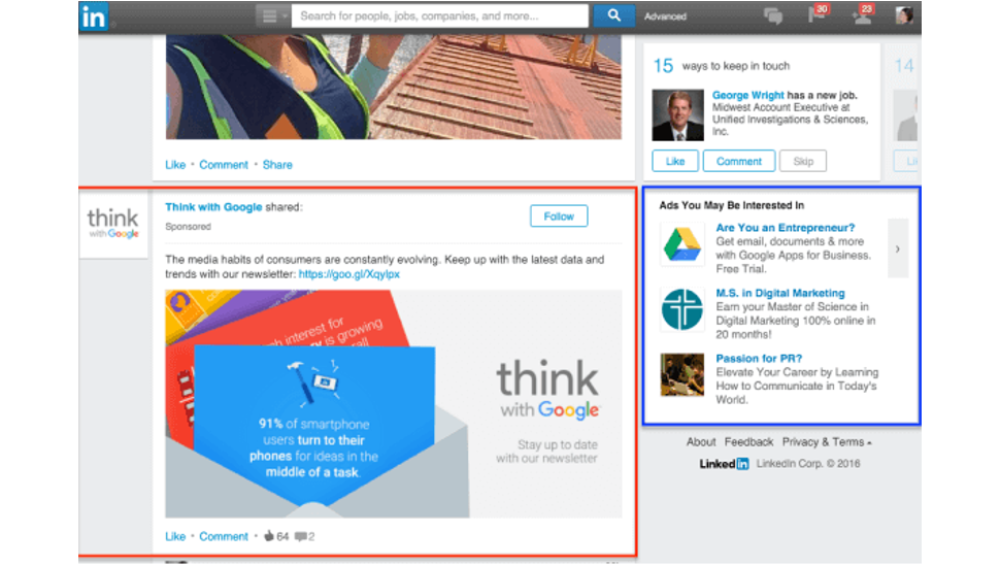Make Your Creative Native With LinkedIn Sponsored Content
12 Jan 2017

The days of Social advertising being an extra “add on” marketing service, for only the large companies, are now long gone. LinkedIn advertising offers unique targeting capabilities with allow you to target professional minded individuals who are online with a career orientated mind set. Sponsored Content Ads are the format that generates the vast majority of paid advertising on LinkedIn. They are part of the quiet revolution in social media advertising where overt ads are becoming less used in favour of native integrated content ads. Understanding what they are and how to set them up to succeed on LinkedIn will be pivotal for any B2Bs wanting to get their foot firmly in the social media door.
What Are Sponsored Content Ads?
In short Sponsored Content Ads are a native form of social media display advertising. They are generated to appear as native posts from your company’s page on LinkedIn, seamlessly blending with the user’s feed, while in reality they are a paid form of advertising. They include a title, high quality image and link to a form of content you wish to share. If you already run text ads on LinkedIn, a huge advantage over these is that they look 10 times better than the small text ads in the corner of the user’s vision. Sponsored Content is at the forefront of the user’s feed, an ad hidden in plain sight. Another advantage is that unlike the pricier image Display Ads LinkedIn offers, Sponsored Content CPCs are on par with that of text ads at around £3/4.
Why Use them?
HubSpot increased leads by 400% using sponsored content ads according to this LinkedIn case study. However, HubSpot are a text-book exemplar of the kind of business LinkedIn ads were made for, as they are directly targeting those seeking to better themselves in order to climb the professional ladder. It is safe to say the results may be less dramatic when your company’s target audience doesn’t exactly match that of LinkedIn. Yet this doesn’t mean that you need to be a recruitment firm (although let’s be honest it does help) to gain some quality traffic via LinkedIn. Many B2B services are also finding huge benefits from being able to target a professional group of people who are online with a rather different mind-set than those exploring other social media, i.e. no videos of cats falling off tables on LinkedIn, the audience is there to think professionally about their career and business, not how many likes their mannequin challenge will get. The targeting options that set LinkedIn apart from other platforms can be put to best use for sponsored content, allowing you to target by factors such as company, role, company size or industry.
Direct Vs Standard Sponsored Content
There are two ways to create sponsored content on LinkedIn, Direct or Standard. With standard Sponsored Content an account manager selects existing content the client already has on their LinkedIn page, adding a bid to sponsor it.
Alternatively, a client can grant permission to an account manager to be able to create Direct Sponsored Content themselves, allowing for a lot greater flexibility. Another benefit of Direct is that content ads you create do not have to appear as a post on the company's LinkedIn page, allowing you to test out various formats to see what works without cluttering up the client’s LinkedIn page.
Ad Specifications
While it’s easy to forget that sponsoring content is essentially creating ads, it still is! This can make for some dry reading, but if you stick to the following list of character limits, your message will avoid truncation on any device.
In terms of general best practice for content creation, you want to be relevant, short and authentic. Successful posts lean more towards the informative and interesting snippets; for example, rather than a run of the mill “Buy Online Course Here” try something along the lines of “5 Ways You Can Boost Productivity”. It is also important to use a high quality image that will engage users. LinkedIn will automatically scrape an image from the link you provide, however an insider tip would be to remove this and upload another separately as this will unsure the highest quality and the exact image you want.
For B2B specifically I would focus on the interesting facts and content that highlights something intriguing about your company’s work, always remembering that you want to be offering insights to users. There are various tactics that can be used in terms of content format, so by no means feel you have to stick to just one way of doing things.
Structuring & Targeting Your Campaigns
Finally, just a note on structuring your campaigns. Generally, within LinkedIn it makes sense to split out campaigns by targeting method. This will allow you to see which of LinkedIn’s audience targets work best for you. Testing different content is certainly worthwhile yet most importantly you should aim to keep content fresh, changing it at least every 2-3 months as no one wants to read an outdated post.
Concluding Thoughts
LinkedIn has become a key player for B2B social media advertising. Despite the high CPCs compared to other social media, the capacity to use specific professional associated targeting and native advertising formats is the advantage. Sponsored Content Ads offer the chance to engage your audience in a different way, informing and intriguing them with content that offers them something back. This in combination with a high quality graphic can be used for branding and to a lesser extent lead generation. Overall performance seems to vary a good deal from business to business, so taking the time to consider whether you or your client have a compatible audience is always important.
To read this blog by Kezia Stewart on the Periscopix website, please click here.

Please login to comment.
Comments